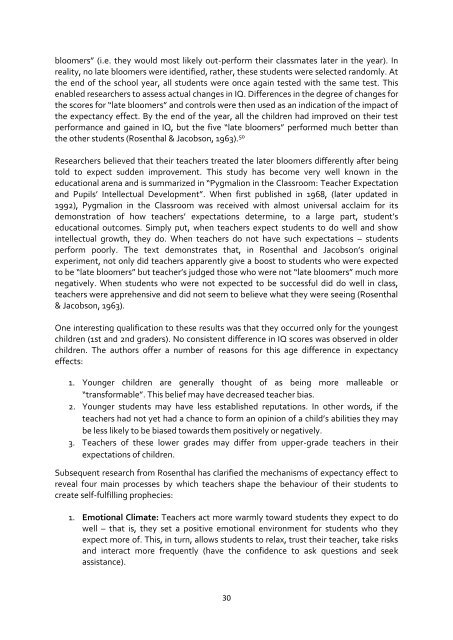UNCONSCIOUS BIAS AND EDUCATION
unconsious-bias-and-education
unconsious-bias-and-education
You also want an ePaper? Increase the reach of your titles
YUMPU automatically turns print PDFs into web optimized ePapers that Google loves.
loomers” (i.e. they would most likely out-perform their classmates later in the year). In<br />
reality, no late bloomers were identified, rather, these students were selected randomly. At<br />
the end of the school year, all students were once again tested with the same test. This<br />
enabled researchers to assess actual changes in IQ. Differences in the degree of changes for<br />
the scores for “late bloomers” and controls were then used as an indication of the impact of<br />
the expectancy effect. By the end of the year, all the children had improved on their test<br />
performance and gained in IQ, but the five “late bloomers” performed much better than<br />
the other students (Rosenthal & Jacobson, 1963). 50<br />
Researchers believed that their teachers treated the later bloomers differently after being<br />
told to expect sudden improvement. This study has become very well known in the<br />
educational arena and is summarized in “Pygmalion in the Classroom: Teacher Expectation<br />
and Pupils’ Intellectual Development”. When first published in 1968, (later updated in<br />
1992), Pygmalion in the Classroom was received with almost universal acclaim for its<br />
demonstration of how teachers’ expectations determine, to a large part, student’s<br />
educational outcomes. Simply put, when teachers expect students to do well and show<br />
intellectual growth, they do. When teachers do not have such expectations – students<br />
perform poorly. The text demonstrates that, in Rosenthal and Jacobson’s original<br />
experiment, not only did teachers apparently give a boost to students who were expected<br />
to be “late bloomers” but teacher’s judged those who were not “late bloomers” much more<br />
negatively. When students who were not expected to be successful did do well in class,<br />
teachers were apprehensive and did not seem to believe what they were seeing (Rosenthal<br />
& Jacobson, 1963).<br />
One interesting qualification to these results was that they occurred only for the youngest<br />
children (1st and 2nd graders). No consistent difference in IQ scores was observed in older<br />
children. The authors offer a number of reasons for this age difference in expectancy<br />
effects:<br />
1. Younger children are generally thought of as being more malleable or<br />
“transformable”. This belief may have decreased teacher bias.<br />
2. Younger students may have less established reputations. In other words, if the<br />
teachers had not yet had a chance to form an opinion of a child’s abilities they may<br />
be less likely to be biased towards them positively or negatively.<br />
3. Teachers of these lower grades may differ from upper-grade teachers in their<br />
expectations of children.<br />
Subsequent research from Rosenthal has clarified the mechanisms of expectancy effect to<br />
reveal four main processes by which teachers shape the behaviour of their students to<br />
create self-fulfilling prophecies:<br />
1. Emotional Climate: Teachers act more warmly toward students they expect to do<br />
well – that is, they set a positive emotional environment for students who they<br />
expect more of. This, in turn, allows students to relax, trust their teacher, take risks<br />
and interact more frequently (have the confidence to ask questions and seek<br />
assistance).<br />
30


